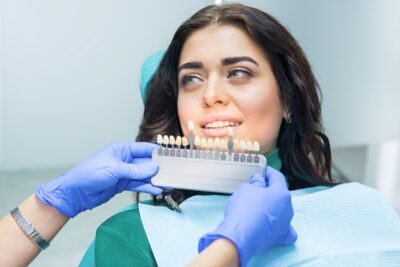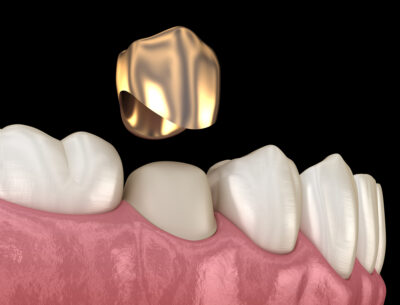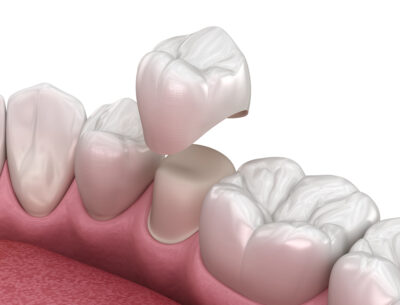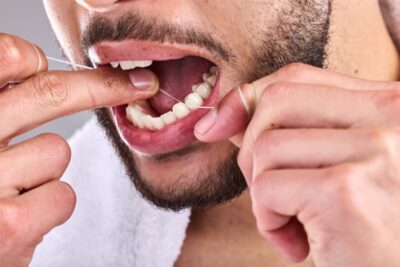
Most people are a little nervous about a trip to the dentist’s office. This is especially true if a significant change to your smile, like a dental crown procedure, is needed. However, a dental crown procedure can be a teeth-saving initiative that is perfectly safe and can enhance the health and appearance of your teeth from the inside out.
The American Dental Association recommends dental crowns, which can serve as a solution to multiple oral health issues. As such, problems ranging from a cracked or broken tooth to a damaged or weak tooth can all be addressed with a dental crown. According to the National Institute of Health, people with dental crowns accounted for 31.3% of the total population. Therefore, a dental crown procedure is a common and simple procedure, provided the entire process is completed with proper care.
So, if your dentist’s office has recommended a dental crown procedure (and you’re concerned about what the crown procedure may entail), read on to learn everything you need to know about dental crowns. As Bay Area dental specialists, we’re here to guide you through the process, ensuring you understand every aspect of your dental care journey.
Table of Contents
Different Types of Crowns for Teeth
What’s the Best Type of Crown for You?
Step by Step Dental Crown Procedure
Frequently Asked Questions About a Dental Crown Procedure
Discover the Benefits of the Dental Crown Procedure
What are Dental Crowns?
A dental crown is a cap or a covering that fits over an existing natural tooth. Your dental specialists or dental laboratory may recommend a dental crown procedure for the following reasons:
- You have had root canal treatment.
- You need to hold a dental bridge or denture in place.
- You have a weak tooth that needs to be strengthened.
- You have a chipped, decayed, cracked, or badly damaged tooth that needs to be protected.
- You have a dental implant that should be covered.
- You have a tooth that is discolored, stained, or severely worn.
Different Types of Crowns for Teeth
While a temporary crown is typically made of acrylic or metallic material, permanent crowns can be made of varying materials, depending on your teeth and unique oral health needs.
Generally speaking, permanent crowns fall into the following types of crowns.
Porcelain-fused-to-metal (PFM) Crowns
Porcelain-fused-to-metal or PFM crowns are known for combining the durability of metal crowns with the natural look of all-porcelain crowns. Additionally, porcelain-fused-to-metal crowns can be color-matched to your adjacent teeth. Moreover, unlike straightforward metal crowns, sometimes the metal that is underneath the porcelain can show a darker line, especially near the gum line.
While PFM crowns combine aesthetic value with durability, there are also some potential drawbacks to PFM crowns for one thing, porcelain-fused-to-metal crowns can cause more wear to opposing teeth or the teeth that make contact with your crown when you close your mouth. In addition, the porcelain coating on your tooth may chip over time, revealing the metal crown underneath. Even so, PFM crowns can restore both front and back teeth and typically last as long as metal crowns.
Metal Crowns
There are several metals that can be used for a metal crown. Additionally, popular examples include gold crowns, stainless steel crowns, or crowns made from palladium, nickel, and chromium. Metal crowns rarely chip and last a very long time. They also are well-suited for withstanding chewing forces, which makes it easier to eat harder foods.
With that being said, the main drawback of this type of crown is the color.
A metal crown type will be noticeably different from surrounding teeth and other teeth, so they are best suited for out- of -sight molars. Therefore, since these crowns can be made of different types of metals, some patients may opt for an eye-catching crown on the front teeth, like a gold crown. It should also be noted that this crown type is not suited for patients with metal allergies, and a different crown type should be selected instead to avoid an allergic reaction.
All ceramic or Porcelain Crowns
All ceramic or porcelain crowns can mimic the appearance of your other teeth more than any other type of crown.
As such, they are well suited for front teeth or any tooth or area in the mouth where the new crown should match the surrounding teeth for the best results.
Ceramic crowns and porcelain crowns are also a good choice for patients with metal allergies. However, while the inherent properties may vary, dental lab technicians can make ceramic crowns from many different materials, like zirconium dioxide, which can withstand heavier forces than other types of crowns. As a bonus, ceramic crowns and porcelain crowns are also gentler on opposing teeth, resulting in less enamel wear. As such, a porcelain or ceramic crown is a popular option for maintaining a brilliant smile built to last without discomfort.
Same-day Dental Crowns
Same-day dental crowns are created with e CAD/CAM (computer-aided design and manufacturing) technology to create crowns in the dentist’s office while you wait. The primary advantage of same-day crowns is that a second visit isn’t required. However, same-day crowns aren’t for all patients, and your dentist should be consulted before opting for this type of crown. It’s important to discuss this with your dentist, especially if the main reason why you prefer same-day dental crowns is to spend less time in the dentist’s chair.
What’s the Best Type of Crown for You?
Remember that dental crowns can be made from many different materials or combinations of materials. The above list of crown types is just a sample, and your dentist will help you determine the best path forward. At Pannu Dental Group, we use highly advanced and durable porcelain or porcelain-fused-to-gold crowns to rejuvenate your smile while restoring full-bite function for a treatment lasting 20-30 years.
Step by Step Dental Crown Procedure
While the exact process for your dental crown procedure may vary based on your unique oral health needs and the recommendations of your dentist. It is very common for dental crown procedures to be completed over the course of two visits.
First Visit to the Dentist
On your first visit, your dentist will perform the following steps to prepare your tooth for a future dental crown.
Tooth Preparation
To prepare the affected tooth for a dental crown, your dentist will need to remove some of your natural enamel. This makes space for your new crown and ensures that it stays in place once affixed. A filling material may also be applied to build up certain parts of your tooth as needed. Regardless of whether filling material is needed the purpose of this step is to have a prepared tooth ready for your new crown placement.
Dental Impressions
Once your tooth has been prepared for your new crown, your dentist will take impressions of your teeth, which will be sent to the dental laboratory to create your custom dental crown. It takes two to three weeks for the dentist’s lab to create the new crown to ensure the crown meets all precise specifications.
Temporary Dental Crown Placement
While you are waiting for your custom dental crown to be created, your dentist will likely place a short-term crown as a temporary restoration of your smile. Temporary crowns are typically made of resin or acrylic. Also, a temporary crown can be used comfortably until your second visit.
Note that temporary crowns are not a permanent solution. Therefore, you should make sure that you keep your second dentist’s appointment which is where the permanent crown will be placed. Temporary crowns allow you to enjoy a better smile and perform normal chewing functions. However, as the name implies, temporary crowns are not for the long term. As such, to maintain temporary crowns, most dentists recommend that patients do the following between office visits:
- Avoid sticky and chewy foods, which can damage a temporary crown
- Try to minimize the side of your mouth where the temporary crown is located
- Avoid hard foods, which could lead to a chipped crown or loose temporary crown
- Slide, rather than lifting our dental floss, when cleaning your teeth to avoid accidentally removing the temporary crown.
- If your temporary crown feels loose, contact your dentist immediately
Second Visit to the Dentist
When your new crown is ready, you’ll have your second visit to remove any temporary crowns as needed and place your new permanent crown.
- During your second visit, your dentist will remove your temporary crown and double check the fit and the color of the permanent crown to ensure it can be affixed permanently to the tooth with dental cement.
- If the new, permanent crown fits perfectly, the dentist will use an anesthetic to numb the tooth and will then put the permanent crown in place with long-lasting dental cement. Your dentist will then ensure the crown fits perfectly after it has been added, and a follow-up visit may be scheduled just to make sure the entire tooth (or rather the entire crowned tooth) has no issues whatsoever.
Frequently Asked Questions About a Dental Crown Procedure
If you need a dental crown procedure for a weak or damaged tooth, chances are you’ll have many questions before, during, and after the crown has been placed on your affected tooth.
Answers to these questions (and guidelines to protect your tooth for the long run) are as follows.
How Long Does a Dental Crown Procedure Take?
Temporary crowns and permanent crowns can both be added to a tooth in a same-day procedure during a single office visit. Crown placement is a relatively streamlined and non-invasive process, especially when working with an expert on dental crown procedures, like Pannu Dental Group.
How Long Will it Take to Recover After a Dental Crown Procedure?
Once the crown placement is complete, most patients can resume work, school, and everyday activities immediately after the temporary crown or permanent crown has been added to the tooth.
With that being said, you may have a slight tenderness or soreness in your gums for several days, and your dentist will likely recommend that you avoid the following foods after your crown placement:
- Ice cubes
- Hard nuts
- Popcorn with kernels
- Sticky or excessively chewy foods like caramels or taffy
How Do You Care for Dental Crowns?
To protect the tooth where the crown has been added, your dentist will likely recommend that you adhere to the following guidelines. (Keep in mind that these guidelines for protecting your crown are not different from other routine initiatives to prevent tooth decay, and gum disease and to otherwise maintain your oral health.)
- Brush your teeth, including your crowned tooth, at least twice a day using a fluoride-based toothpaste and a soft-bristled toothbrush.
- Be sure to floss daily and slide the dental floss instead of lifting it out if you have a temporary crown and are waiting for your permanent crown to be complete.
- Use an antibacterial mouthwash to prevent dental plaque and bacteria that may lead to additional tooth decay.
- Avoid very hard or chewy foods, especially when a temporary crown is in place.
- Talk to your dentist about any oral habits that may hinder your new crowned tooth (as well as your natural teeth), such as grinding or clenching. Your dentist may recommend a custom mouth guard or other solution to these common but potentially damaging oral health issues.
- Be sure to keep all follow-up appointments with your dentist to ensure the affected tooth, and all of your other teeth remain in pristine condition.
Is a Dental Crown Painful?
Placing a dental crown should not be painful to the affected tooth or your other teeth, as a dental crown procedure is a simple and non-invasive treatment. A little tooth or teeth sensitivity is normal, but you should not expect tooth pain that interrupts your everyday activities, even immediately after your dental crown procedure.
During the dental crown procedure, simply let your dentist know if your tooth or teeth are experiencing pain. Your dentist can apply more anesthetic to ensure your crowned tooth is comfortable.
How Do I Know if There is a Problem with my Dental Crown?
If you have a recently added dental crown, you should call your dentist immediately if you notice any of the following:
- A loose crown on your tooth
- Cracks or chips in your crowned tooth
- Sharp edges on your tooth that bother your other teeth, your tongue, your gums, or other areas of your mouth
- Bad breath or a bad taste
- Changes in your tooth or other surrounding teeth may indicate a different oral health issue.
How Long Does a Dental Crown Procedure Last?
One of the most significant benefits of a dental crown procedure is that it protects your teeth for the long haul while fully enhancing your smile. Permanent crowns are built to last, especially if you opt for a dental group that uses the best and most modern materials available for dental crowns. At Pannu Dental Group, a dental crown procedure is expected to last up to 20-30 years without issue or discoloration, meaning you’ll have a beautiful smile for decades to come.
Discover the Benefits of the Dental Crown Procedure with Pannu Dental Group
The first step to brightening your smile and enhancing your oral health is to connect with the professional and expert team at Pannu Dental Group. Whether you are worried about a chipped tooth, damaged tooth, weak and loose tooth, or simply a tooth that isn’t the same color as your other teeth, we can help.
At Pannu Dental Group, recognized as the best dentists in San Jose, California, we specialize in dental crowns and use the latest technology to ensure your dental crown enhances your tooth and oral health in every way possible. A brighter and brilliant smile is just a visit away, so reach out to our team today to learn more about dental crowns and how we can enhance your oral health and appearance for a lifetime.

Dr. Dalvir S. Pannu has been a practicing dentist since 1995. In 1996 he opened his first dental practice in India, where he gained invaluable experience and acumen. In October of 1997 he was invited by the American Dental Association (ADA) to present the table clinic on Endodontics, at their annual session held in Washington, D.C. At this time he fell in love with the United States and became passionate about practicing dentistry in California. He became particularly enamored of the San Francisco Bay area, and soon took up residence and work here.






